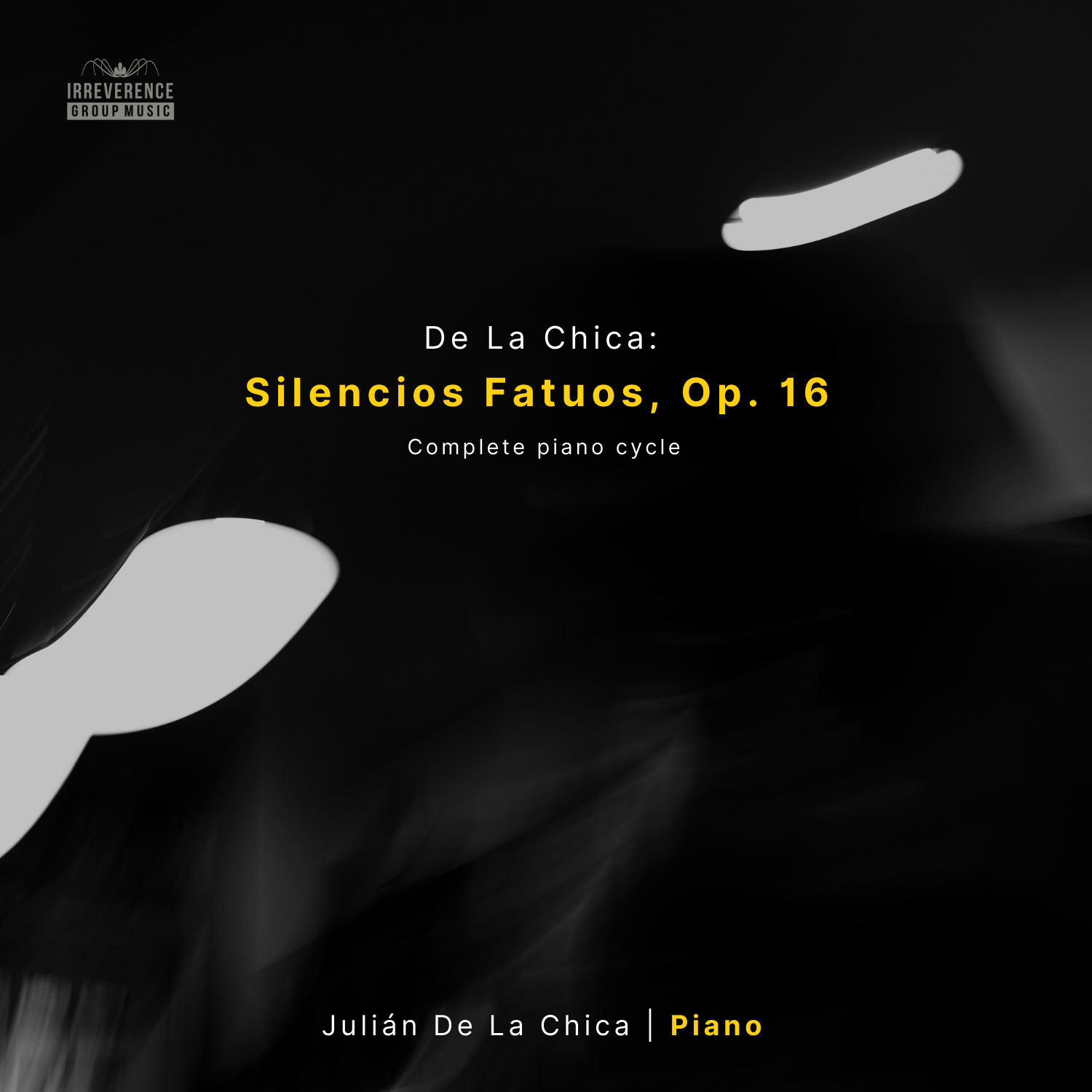Silencios Fatuos, Op. 16
Release: Novemeber 19, 2021
Irreverence Group Music presents Silencios Fatuos Op. 16, a new piano cycle by composer Julián De La Chica. In this cycle, De La Chica explores in an intimate and crude way, his relationship with the piano, and the sound search for the abyss, as a starting point. De La Chica entertains us into emptiness, absence and silence, as preponderant elements on this path. As the musicologist & composer Campos-Fonseca wrote: In Silencios Fatuos the artist gradually sheds his skins, confronting the very fatuity of postminimalism. And in this way, he seems to sprout abstaining from any violent rebellion, in a kind of superfluity, allowing the passage of time, building surfaces with curved lines that twist on themselves without noise, without groans, contemplating the absurd with an unsettling serenity.
Info:
Silencios Fatuos, Op. 16
Artists:
Julián De La Chica (Piano)
Composer:
Julián De La Chica
Format: Album
Release: Nov 19, 2021
Catalogue: IGM-034
GTIN/EAN/UPC: 4064832732092
Producer: Irreverence Group Music
Tracks:
Silencios Fatuos, Op. 16
01. 10 Silencios Fatuos, Op. 16: No. 1
02. 10 Silencios Fatuos, Op. 16: No. 2
03. 10 Silencios Fatuos, Op. 16: No. 3
04. 10 Silencios Fatuos, Op. 16: No. 4
05. 10 Silencios Fatuos, Op. 16: No. 5
06. 10 Silencios Fatuos, Op. 16: No. 6
07. 10 Silencios Fatuos, Op. 16: No. 7
08. 10 Silencios Fatuos, Op. 16: No. 8
09. 10 Silencios Fatuos, Op. 16: No. 9
10. 10 Silencios Fatuos, Op. 16: No. 10
Photo by Julián De La Chica
Album notes
By Susan Campos-Fonseca
"Beauty is not a substance in itself but only a drawing of shadows", Junichiro Tanizaki wrote. The postminimalism of the 21st century is a play of shadows. The tonal systems of the past, their harmonic, melodic and rhythmic structures, based on geometrizations and sound tensions that were supposed to build times and spaces, found in Western postcolonial minimalist thought, the essential aphorism.
These shadows derived from centuries of accumulation in our modern way of listening seem to lead us to fatuity. Perhaps for this reason minimalist thought sought in Eastern philosophy and non-Western knowledge what it understood as "formulas" to appropriate, once again, with the presumption that such reduction to essentials was possible. The dogma of the Western ratio was revealed in its fatuity before the "absence" and the "shadow" cultivated by sound knowledge and surviving listeners who were not reducible to the systems of academic composition. In 4:33 (1952) and in his essay Silence (1961), John Cage manifests having become aware of this fatuity.
Julián De La Chica
Photo by Miguel Mourato-Gordo
Morton Feldman, in a dialogue with painter Brian O' Doherty, wrote: "A music that has surface builds with time. A music that has no surface submits to time and becomes a rhythmic progression." The black paintings in the Rothko Chapel come close for me to the vibrational sensation that a music in such terms could give us. Feldman looks not to non-Western knowledge but to painting for answers to think sonically about the fatuous ratio that persists in compositional systems, namely: controlling time, turning sound into an idea.
The current pianistic postminimalism draws heavily from Ambient music, this is how it tries to build surfaces. We hear it in popular figures such as Max Richter, Hania Arani, Olafur Arnalds or Nils Frahm. In the Silencios Fatuos (2021) by Colombian composer Julián De La Chica, this search seems to find threads that weave with the phosphorescent and radioactive shadows left by the twentieth century, and to which we return when listening to the flashes of sonorities that refer us to Ryuichi Sakamoto or David Sylvian.
Julián De La Chica
Photo by Miguel Mourato-Gordo
In previous productions, such as the Preludes Op. 8, and his Voyeuristic Images Op. 10, De La Chica's pianism shows a constant exploration and research. The composer-pianist urges within the parameters of the "new simplicity", challenging himself in a kind of minimal eroticism.
In Silencios fatuos the artist gradually sheds his skins, confronting the very fatuity of postminimalism. And in this way, he seems to sprout abstaining from any violent rebellion, in a kind of superfluity, allowing the passage of time, building surfaces with curved lines that twist on themselves without noise, without groans, contemplating the absurd with an unsettling serenity.
Susan Campos-Fonseca, PhD
Musicologist & composer
Julián De La Chica
Photo by Miguel Mourato-Gordo
Silencio Fatuo No. 3
Credits
Produced by Irreverence Group Music
Music by Julián De La Chica
Julián De La Chica (Piano)
Recorded by Greg DiCrosta
at Firehouse 12, New Haven, CT
Mixed by Julián De La Chica
at IGMusic Lab, Brooklyn, NY
Mastered by Shochi Shams
Performed on Steinway “D” Hamburg (CD-79)
Piano Technician: Timothy J. Robinson
Album Notes by Susan Campos - Fonseca
Cover design by IGM
Photography by Miguel Mourato-Gordo
Cover photography by Julián De La Chica
Julián De La Chica 's music is Published
by Vagabundo music Publishing, INC (BMI)
Manufactured and marketed by
Irreverence Group Music (Brooklyn, NY)
Made in US. Total time: 58 min
Ⓟ and Ⓒ 2021 IGM






